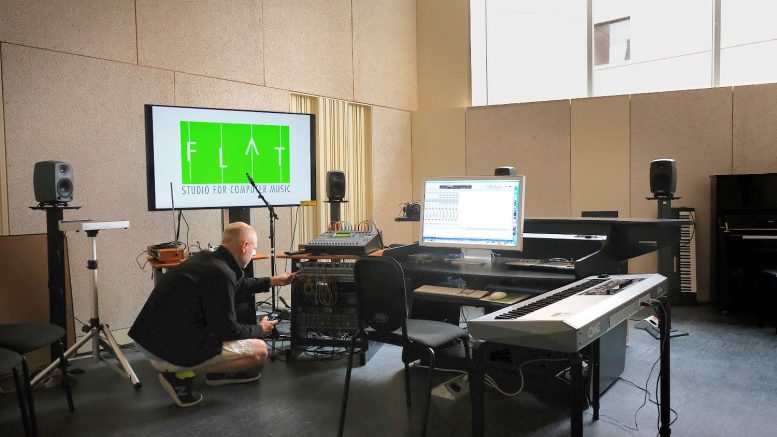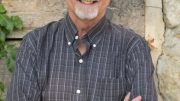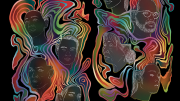Computers have been integral to music composition since the 1950s, evolving from room-sized monstrosities to the personal computers we use today.
In the 1980s and ’90s, computers became commonplace tools for musicians. With the advent of digital audio workstations (DAWs), music composition and production became more accessible.
For Örjan Sandred, Swedish composer and Desautels faculty of music professor in composition, computer technology goes beyond recording and composing on digital platforms, opening doors to new ways of thinking about music. While traditional music notation remains important, computers and AI allow composers like Sandred to explore alternative ways to create and manipulate sounds.
Sandred’s journey into the world of composition and technology began during his time as a student. Among his teachers was Finnish composer Magnus Lindbergh.
“He was really fascinated by how you could work with computers as assisting you when you compose music,” Sandred recalled. “Everything he told me intrigued me.”
Sandred’s curiosity led him to further explore this realm, eventually bringing him to the renowned Institute for Research and Coordination in Acoustics/Music in Paris. It was there that he deepened his understanding of computer technology’s potential in music composition.
Earlier this month, Sandred was elected as a new fellow of the Royal Society of Canada — a renowned scholarly organization in Canada that acknowledges outstanding achievements in research and arts.
Sandred founded the Desautels faculty of music’s Studio FLAT — a hub for both faculty and students, where they explore the possibilities of electronic and computer music.
“It’s pushing the boundaries for how you can use technology in music,” he said.
At Studio FLAT, Sandred’s focus is not on popular music or recording music, but on finding new ways to create sounds and approach music from different angles. The goal is to encourage students to think beyond conventional music-making methods and embrace technology as a tool to reshape the future of music.
Within the studio, Sandred employs specialized software designed to manipulate and reshape sounds such as DAWs. With a DAW, one can record sounds, incorporate synthesizers and orchestrate sound sequences, similar to the workings of a tape recorder but executed digitally within a computer. The studio also uses software in score composition, helping arrange musical notes into coherent and meaningful musical instructions.
“It’s a symbolic way of working with music,” Sandred said. “Not the sound directly but instructions.”
Typically, those studying composition in the Desautels faculty of music take three courses involving Studio FLAT — the first of which is open to U of M students from outside the faculty.
“They get the challenge to make music out of any type of sound that they can put inside the computer,” Sandred said.
This process begins with recording various sounds, and the possibilities are endless — from capturing the chirping of a bird to recording the rumble of a passing car. Sandred emphasized that not every sound is inherently musical, so it is the approach and attitude that matters when trying use sounds to make music.
In his sessions with students, discussions delve deep into the essence of music, exploring questions like “What is music?” and “How do we imbue sounds with meaning?”
Here, technology plays a pivotal role by enabling students to transform unconventional sounds into musical compositions.
“There’s another side of sounds that we can explore now with the help of technology,” he said.
Teaching composition and being able to witness students’ creative growth and transformation during their four-year undergraduate journeys is a deeply rewarding experience for Sandred.
“I think it’s really cool to see someone grow with their ideas,” he said.
In his research, Sandred focuses on rule-based computer assisted composition techniques. “This is a way to define music,” Sandred explained.
When learning music theory, one is typically instructed in a specific musical style and taught how to create music in that style by following a set of rules — what to do and what not to do. Sandred’s interest lies in the broader application of rules as a tool for creating music.
Think of the legal system, for instance. It is made up of numerous rules and laws, each seemingly straightforward on its own but collectively forming a complex web of interactions. Similarly, Sandred said, working with a multitude of rules in music, even simple ones, can lead to intriguing interactions and side effects, which can shape compositions and create unique musical experiences.
The composer’s exploration of computer technology’s role in music and the arts is driven by the desire to remain connected to the ever-changing world and to create art that resonates with the present moment.
To Sandred, adapting and evolving with the tools and technologies available is intrinsic to the role of art. As people navigate their way through history and cultural backgrounds, art helps them understand who they are and allows them to express themselves in the context of their time.
“The role of art is to follow along,” Sandred said, “and I think art has to adapt to what’s going on.”
Computer technology has played a pivotal role in shaping music for over a century, particularly in popular music, where effects and innovations have transformed the musical landscape.
Sandred believes computer technology is a tool that can help artists remain connected and engaged with contemporary issues.
“Whatever we want to do, we have to somehow relate it to society to make art and music meaningful.”





